Key Takeaways
- ChatGPT can generate code, debug issues, and help with documentation for many programming languages. It's great for Python, JavaScript, and HTML/CSS.
- To get helpful code from ChatGPT, be specific and detailed in your prompts. Break complex tasks into smaller parts and adjust your requests based on feedback. This approach will help you get accurate and relevant code snippets.
- ChatGPT can sometimes suggest outdated or insecure code. Constantly review and test what it generates. Use it alongside traditional learning and peer reviews to ensure your code is reliable and secure.
Stop overpaying - start transferring money with Ogvio. Join the waitlist & grab early Rewards NOW! 🎁
ChatGPT has gathered over a million daily users in just five days of its launch. As the platform quickly gained traction in the tech industry, questions like "Can ChatGPT write code?" started popping up. Its ability to generate and understand code has piqued the interest of developers across the globe. Recent research shows that ChatGPT is becoming a go-to programmers' tool, destroying platforms like StackOverflow and Github forums.
Despite its growing popularity, understanding how ChatGPT can be harnessed for coding takes time. You might assume that such a versatile tool would be straightforward for all coding tasks, but it’s a little more complex.
While ChatGPT is a powerful tool, combining it with other AI tools can improve productivity even more. For instance, Writesonic is excellent for content generation and can help you create detailed documentation or blog posts about your coding projects.
To answer the question, "Can ChatGPT write code?" I will explore ChatGPT's coding capabilities, from generating basic scripts to tackling more intricate programming challenges. So, if you’re curious about how advanced AI can transform your programming workflow, read on.
Table of Contents
- 1. Can ChatGPT Write Code? Getting Started
- 1.1. Basic Prompts to Get You Started
- 1.2. Tips for Effective Prompts
- 2. Core Features of ChatGPT in Coding
- 2.1. Handling Various Languages and Frameworks
- 2.2. Universal Problem Solving
- 3. Interactive Coding with ChatGPT
- 3.1. Live Coding Support
- 3.2. Code Suggestions
- 3.3. Error Analysis
- 3.4. Refactoring Code
- 4. Advanced Uses in Software Development
- 4.1. API Integration and Project Setups
- 4.2. Full Project Setup
- 5. Limitations and Best Practices
- 5.1. Limitations of Using ChatGPT in Coding
- 5.2. Best Practices for Integrating ChatGPT Into Your Workflow
- 6. Case Studies and Real-World Examples
- 7. Conclusions
Can ChatGPT Write Code? Getting Started
Jumping into coding with ChatGPT might initially sound intimidating, but setting it up is a breeze. To fully explore how ChatGPT can write code, you must complete a few steps and set up an OpenAI account.
Latest Writesonic Coupon Found:First off, you need access to ChatGPT. OpenAI provides a platform for using ChatGPT, and you can sign up for an account on their website. Once logged in, you can use the web-based interface or access it through API calls to integrate it into a larger project.
Tools you'll need:
- OpenAI account: Sign up at OpenAI’s website. This is your gateway to using ChatGPT.
- IDE or text editor: Tools like Visual Studio Code, Sublime Text, or even simple text editors can be used to write and test code.
With your OpenAI account and favorite text editor ready, you can start coding with ChatGPT.
Basic Prompts to Get You Started
To get useful outputs from ChatGPT, simple, clear prompts can yield impressive results, too. Here are a few examples:
Hello world in Python: Write a Python script that prints "Hello, World!".
ChatGPT code interpreter responds with:

Simple function in JavaScript: Create a JavaScript function that adds two numbers.
ChatGPT code interpreter gives you:

Basic HTML page: Generate a basic HTML page titled "My First Page" and the heading "Welcome to my website."
The ChatGPT code interpreter output will look something like this:

Do you see how straightforward it is to get ChatGPT to write basic code? Provide a clear prompt, and ChatGPT will deliver the code snippet.
Tips for Effective Prompts
While ChatGPT programming skills are impressive, the quality of its responses depends on your prompts. Here are some tips to make them better:
- Be specific: Clearly state what you need. Instead of saying, "Write code to calculate factorial," try, "Write a Python function that calculates the factorial of a number."
- Break down complex tasks: Divide them into smaller parts for more complex coding tasks. Ask for individual functions or pieces of code and then piece them together.
- Provide context: If a task requires specific details or style, mention that in your prompt. For example, "Write a Python script to scrape a website and save the data to a CSV file."
ChatGPT generates code and can refine it based on feedback from testing stages[1]. After getting your code snippet from ChatGPT, you’ll need to test it. Run the code in your text editor or IDE to see if it works as expected. Suppose it doesn't - tweak your prompt, and try again.
Following these steps will get you on your way to mastering ChatGPT for coding. Whether you're writing simple scripts or tackling more complex programming challenges, ChatGPT programming "knowledge" can be a valuable assistant in your development workflow.
Core Features of ChatGPT in Coding
ChatGPT is like a Swiss army knife for developers. It chats, codes, debugs, and documents. Let's break down its core features to understand how it can be your all-in-one programmer tool.
Handling Various Languages and Frameworks
ChatGPT programming languages and frameworks library is impressive. ChatGPT can assist with Python, JavaScript, Java, C++, Ruby, or even less common languages like Haskell or Lisp[2].
One of the most popular languages today, Python is known for its simplicity and readability. Can ChatGPT write code in Python? Yes, it can do everything from simple functions to more complex programs. For example, if you need a function to calculate the factorial of a number, a prompt I mentioned earlier, "Write a Python function to calculate the factorial of a number," would yield a precise snippet.
Essential for web development, JavaScript is another language where ChatGPT coding excels. Whether you need to manipulate the DOM, create event listeners, or asynchronous functions, ChatGPT can provide clear, functional code. A prompt such as "Create a JavaScript function that adds two numbers and logs the result" will get you a ready-to-use function.
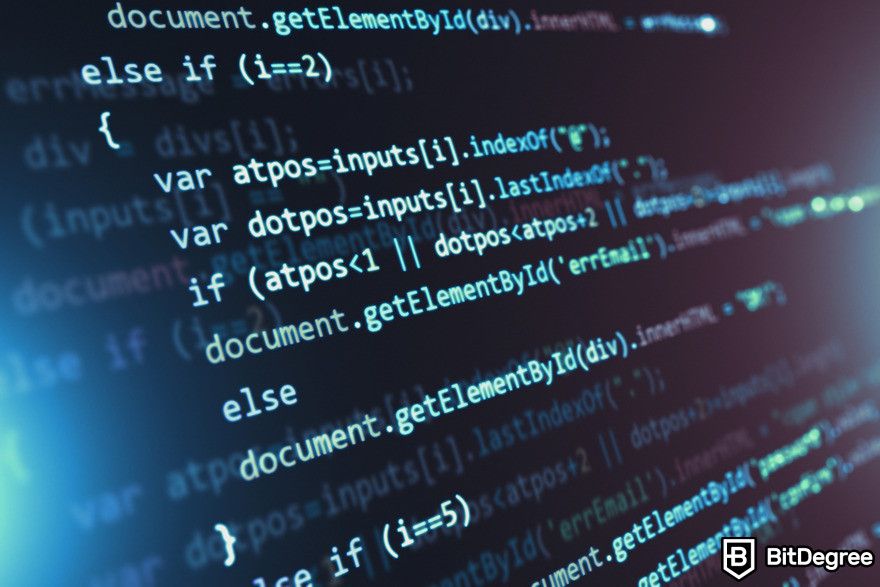
Web developers can benefit from ChatGPT programming ability to generate HTML and CSS. For instance, "Generate a basic HTML page with a styled button" will give you a simple webpage structure with applied CSS styling.
You would be impressed by how well can ChatGPT write code for some frameworks and libraries. Whether Django or Flask for Python, React or Vue for JavaScript, or even front-end libraries like Bootstrap, ChatGPT can provide starting code, component structures, and examples to get you started quickly.
Universal Problem Solving
One of the best ChatGPT code interpreter's features is how can ChatGPT write code for almost any case. It might not be a perfectly working one, but a great start nonetheless. Focusing more on logic and problem-solving than syntax and initial code can save significant time. Here are a few examples of how you can leverage it:
- Function definitions: Need a quick function? Ask ChatGPT, "Write a Python function to check if a number is prime."
- Class implementations: If you need a class, such as a prompt like "Create a Java class for a simple bank account," ChatGPT will give you the structure, attributes, and basic methods.
- Algorithms: For more complex needs, like sorting algorithms or data structures, prompts like "Write a JavaScript function to implement quicksort" should yield efficient and clean code.
Debugging can be tedious and time-consuming. ChatGPT can assist by providing a second set of eyes on your code. If you have a piece of Python code throwing errors, paste it into ChatGPT with a prompt like, "Debug this Python code for errors in the logic." ChatGPT will not only point out syntax errors but can also suggest logical improvements or optimizations. This feature is handy for:
- Syntax errors: ChatGPT can spot and correct mistakes that might have been overlooked.
- Logic errors: It can help identify where the logic might go wrong and suggest better approaches.
- Performance improvements: ChatGPT can suggest more efficient algorithms or data structures by analyzing the code.
Well-documented code is crucial for maintainability and collaboration. ChatGPT can help generate detailed comments and documentation, making your codebase more understandable to others (and yourself in the future).
If you have a function needing documentation, a prompt like "Generate documentation for this Python function" will provide detailed comments explaining what the function does, its parameters, and its return values. This can include:
- Docstrings: Detailed docstrings for Python functions or methods.
- Inline comments: Explanations of complex lines or blocks of code.
- ReadMe files: Generating or updating ReadMe files for your projects to give an overview of what the project is about, how to set it up, and how to use it.
If ChatGPT is insufficient, complete your documentation process using Writesonic; it can quickly generate clear and straightforward guides.
Suppose you’re working on a web scraping project in Python. Can ChatGPT write code for it? Let's find out.
Start with a prompt like, "Write a Python script to scrape the title and URL of articles from [your_website_name] and save them to a CSV file." ChatGPT will provide the necessary imports, the main scraping logic, and the code to write the data to a CSV file.
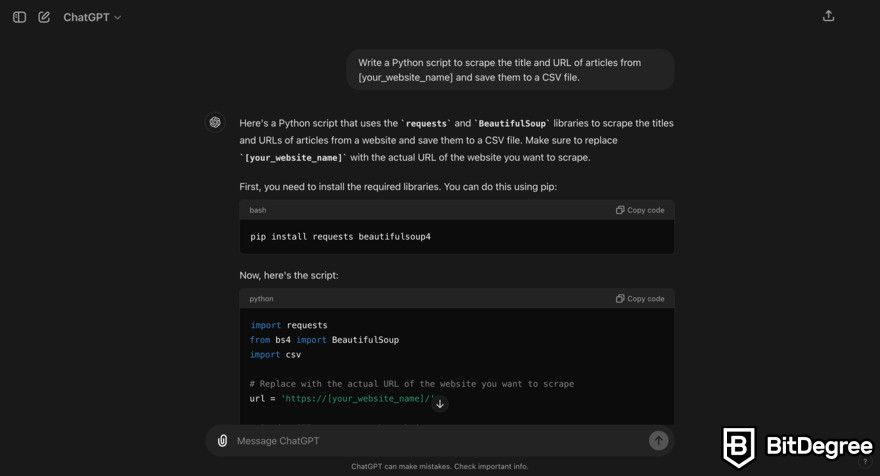
If the initial script throws an error, paste the code back into ChatGPT with a prompt like "Debug this Python web scraping script." ChatGPT will identify and correct issues related to HTTP requests, parsing HTML, or handling CSV files.
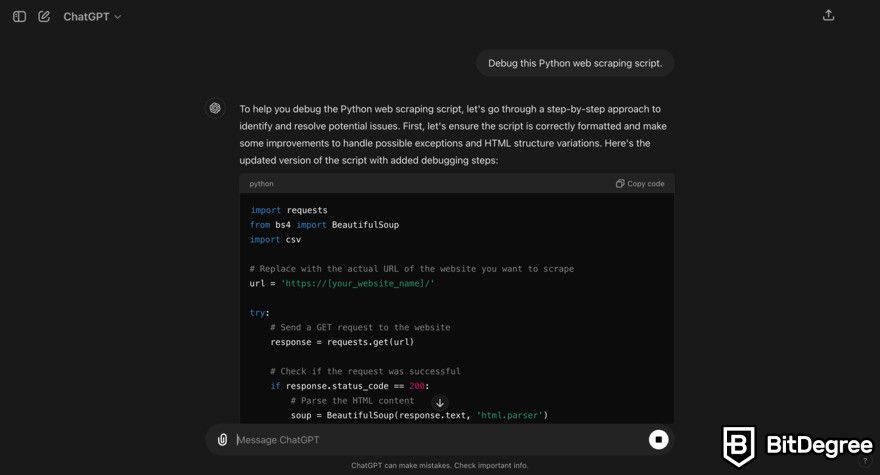
Once the script works, ask ChatGPT, "Generate documentation for this web scraping script." It will add detailed comments and a docstring at the beginning of the file, explaining what the script does, the libraries it uses, and how to run it.

Using ChatGPT in these ways, you can significantly boost your productivity, reduce the time spent on routine tasks, and maintain a higher-quality codebase. Whether you’re a senior programmer or just starting, integrating ChatGPT into your workflow can make coding more efficient and enjoyable.
Interactive Coding with ChatGPT
ChatGPT's capabilities extend beyond generating code snippets; it excels in interactive coding, live support, suggestions, and error analysis. Let's explore how can ChatGPT write code with practical examples.
Live Coding Support
Live ChatGPT coding is like having a personal assistant available 24/7. You can ask ChatGPT for coding help in real time, and it will respond with relevant suggestions and fixes.
Imagine you’re writing a Python script to automate sending emails. Start by asking ChatGPT, "How do I send an email using Python?"
ChatGPT: "You can use the 'smtplib' library. Here's a basic example":
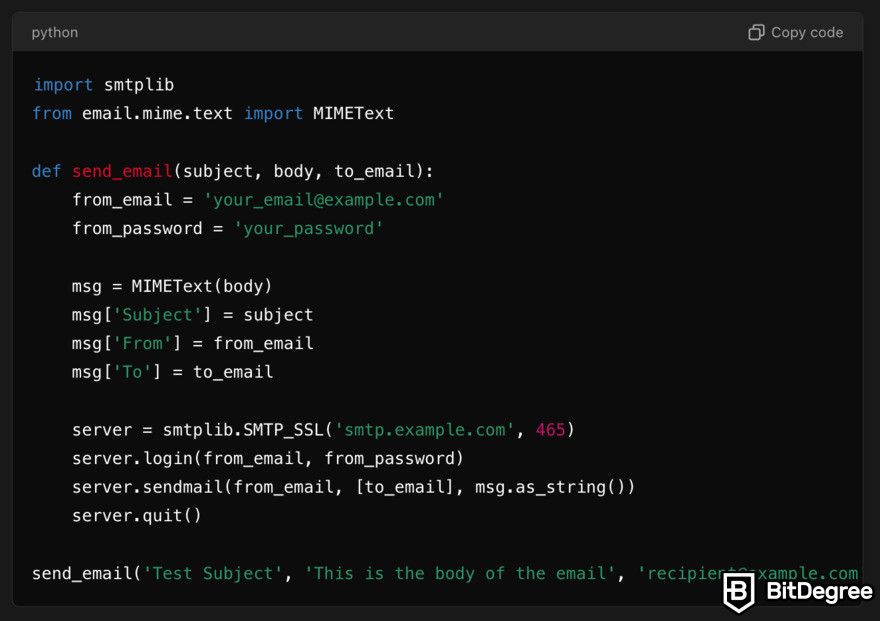
As you build your script, you might encounter an error. Instead of googling for solutions, ask ChatGPT for coding advice directly, "I'm getting an authentication error when sending the email. What could be wrong?"
ChatGPT: "Authentication errors usually occur due to incorrect login details or insufficient permissions. Ensure your email and password are correct and that 'Less secure app access' is enabled in your email account settings."
Code Suggestions
ChatGPT can suggest improvements and optimizations to your code, helping you write cleaner and more efficient scripts.
Suppose you have a function to check if a number is prime:
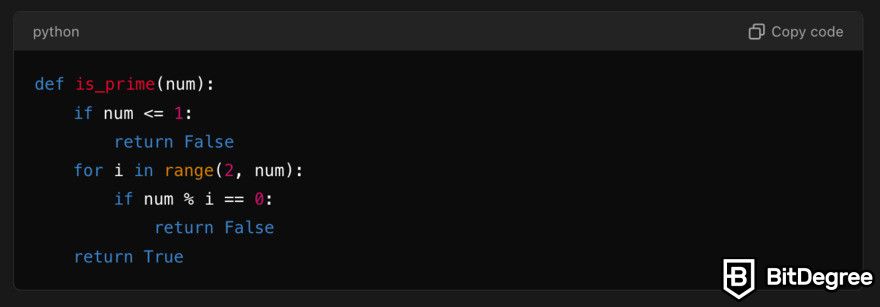
Ask ChatGPT coding suggestions, "Can you optimize this 'is_prime' function?"
ChatGPT: "Sure! You can reduce the number of iterations by checking up to the square root of 'num' and skipping even numbers after checking '2':

With ChatGPT’s suggestions, you’ve made your function more efficient by reducing unnecessary iterations.
Error Analysis
Error analysis is another area where you see how efficiently can ChatGPT write code. It can identify and help you fix syntax and logic errors in your code.
You have a JavaScript function that isn’t working as expected:

The output is '510' instead of '15' because JavaScript combines the string '10' with the number '5'. Ask ChatGPT for help, "Why is 'addNumbers(5, '10')' returning '510' instead of '15'?"
ChatGPT: "The issue is that the second parameter is a string. JavaScript concatenates strings with numbers. You can convert 'b' to a number":

ChatGPT helps pinpoint the problem and provides a solution to ensure the function behaves as expected.
Refactoring Code
Refactoring code is crucial for maintaining readability and efficiency. ChatGPT can assist in updating your code to follow best practices.
Consider a Python class that needs refactoring:
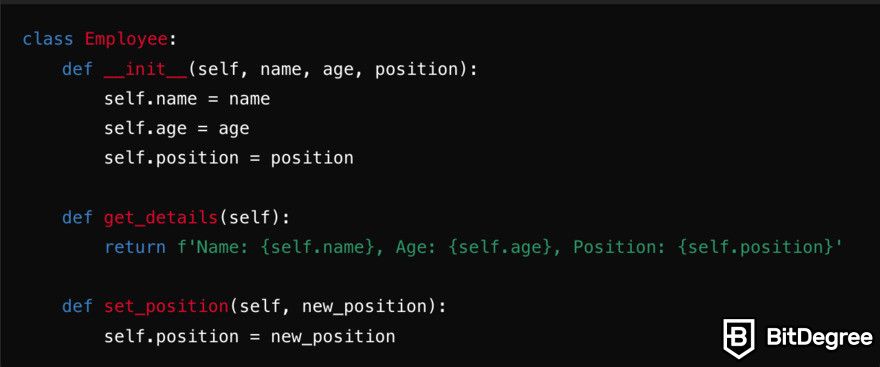
Ask ChatGPT for refactoring advice, "How can I refactor this 'Employee' class to improve it?"
ChatGPT: "You can add type hints and property decorators for better readability and encapsulation":
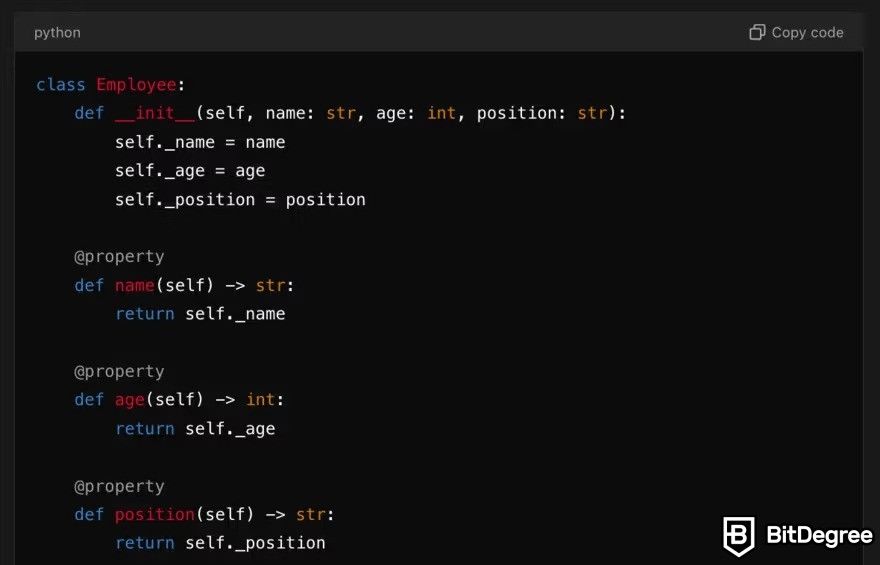
This refactoring improves encapsulation and adds type hints, making the class more robust and easier to understand.
Advanced Uses in Software Development
ChatGPT is a powerful tool in software development, especially for more complex tasks like API integration and complete project setups. It can also be an excellent resource for learning new programming skills. Let's start with how can ChatGPT write code for more advanced API integration.
API Integration and Project Setups
Working with APIs can sometimes be daunting. Can ChatGPT write code that helps with this task? Well, it can simplify the process significantly. Here’s how:
Step 1: Writing API requests. Need to fetch data from an API? Ask ChatGPT to "Write a Python function to get weather data from OpenWeatherMap API."
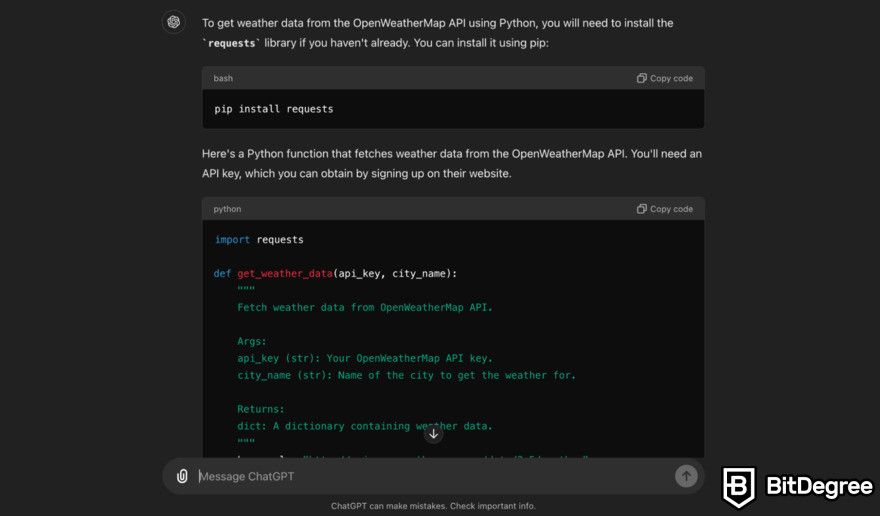
It will give you a Python function that handles the request, including how to format the API endpoint and handle the response.
Step 2: Combining multiple APIs. Suppose you need to pull data from numerous sources. In that case, ChatGPT can show you how to integrate them, "Write a Python script that combines weather data from OpenWeatherMap with user data from a JSONPlaceholder API."

You’ll get a script that fetches and combines data from both sources, merging it into a single dataset.
Step 3: Error handling. It's an important step for reliable API integration. ChatGPT can easily add error handling to your API requests. Ask it, "Add error handling and retries to this API request function."

This makes your code more resilient to network errors or API rate limits.
Full Project Setup
Small tasks are easy, but can ChatGPT write code and set up a whole project? Here's an example of how to write a boilerplate with ChatGPT.
Step 1: Backend setup. Let’s say you’re building a web app with Django. Ask ChatGPT to "Create a basic Django project with an app to manage a to-do list".
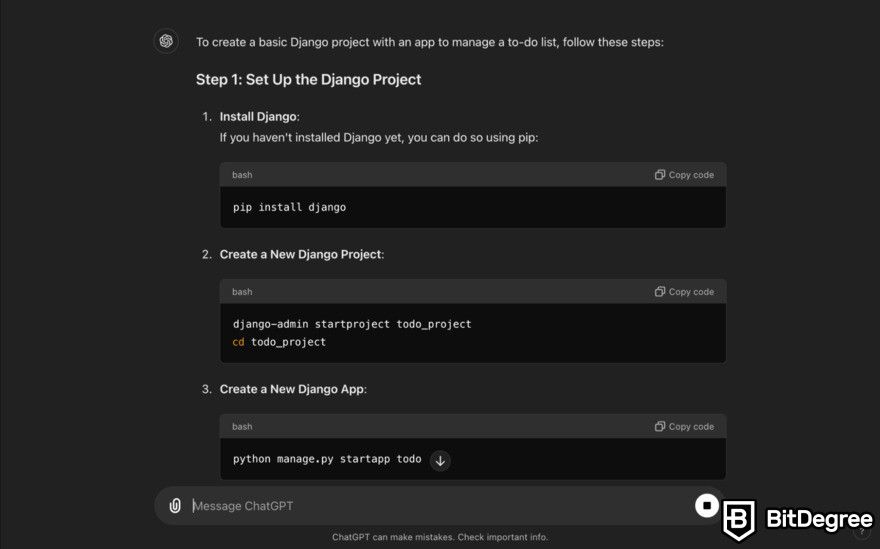
ChatGPT will guide you through setting up your Django project, creating models, views, and URLs, and configuring your database.
Step 2: Frontend setup. Need a frontend for your app? ChatGPT can help with React. Follow with this request: "Create a React component for displaying a to-do list."
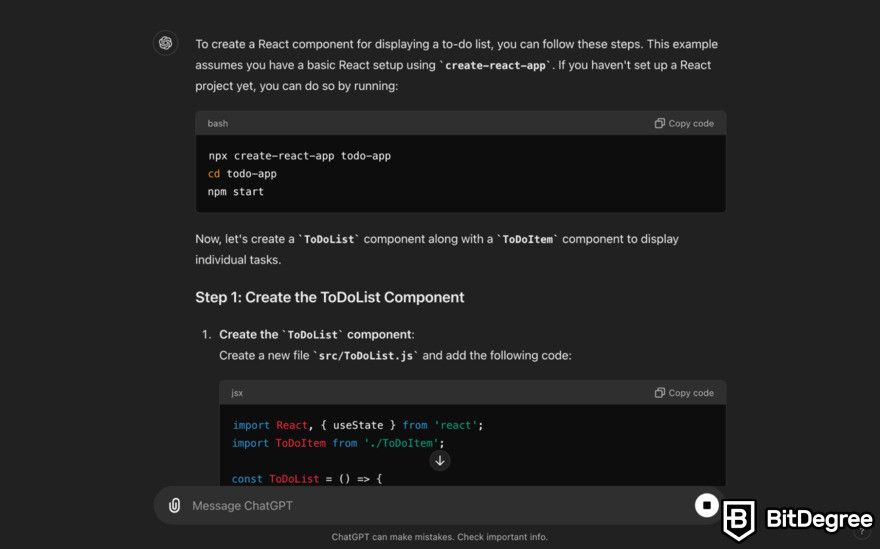
You’ll get a React component that fetches data from your backend and displays it in a user-friendly way.
Step 3: Database configuration. Setting up a database can be challenging, but ChatGPT coding makes it more accessible. Lastly, prompt to "Write an SQL script to create tables for a to-do list application."
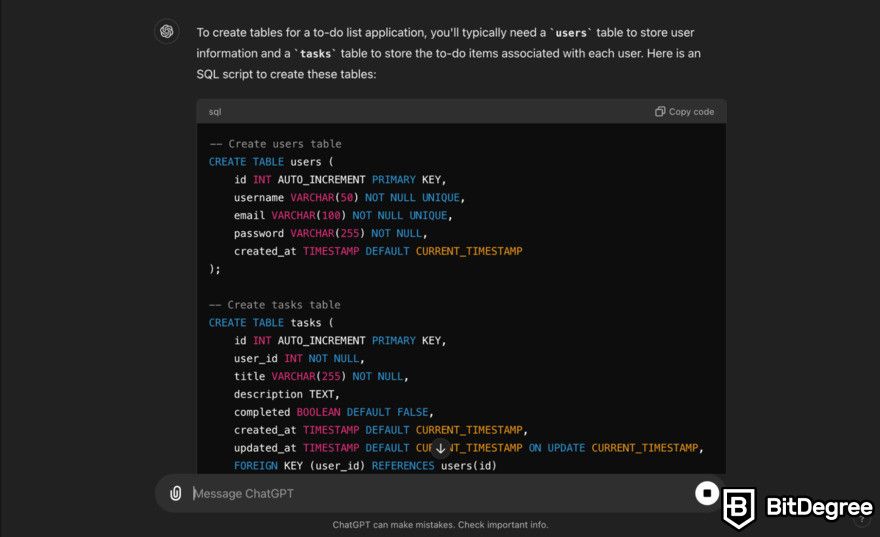
This script will create the necessary tables and define relationships between them.
Using ChatGPT in these ways, you can tackle complex development tasks more efficiently and learn new skills. Whether integrating APIs, setting up projects, or enhancing your coding knowledge, ChatGPT is a versatile assistant in your software development career.
Limitations and Best Practices
While ChatGPT has proven to be a valuable tool for developers, it has limitations. Let's discuss these potential pitfalls and how to use ChatGPT to write code effectively in your development workflow.
Limitations of Using ChatGPT in Coding
ChatGPT's responses are based on patterns and data it was trained on, which can sometimes generate outdated code. This is particularly concerning when dealing with rapidly evolving technologies or frameworks.
Security is another significant concern. ChatGPT might suggest practices that are not secure by modern standards. For instance, it might recommend using outdated libraries or unsafe coding patterns that could expose vulnerabilities.
ChatGPT doesn’t always understand the full context of a project. It generates code based on the prompt provided, which might lead to code that doesn’t fit well with the existing codebase or architectural decisions.
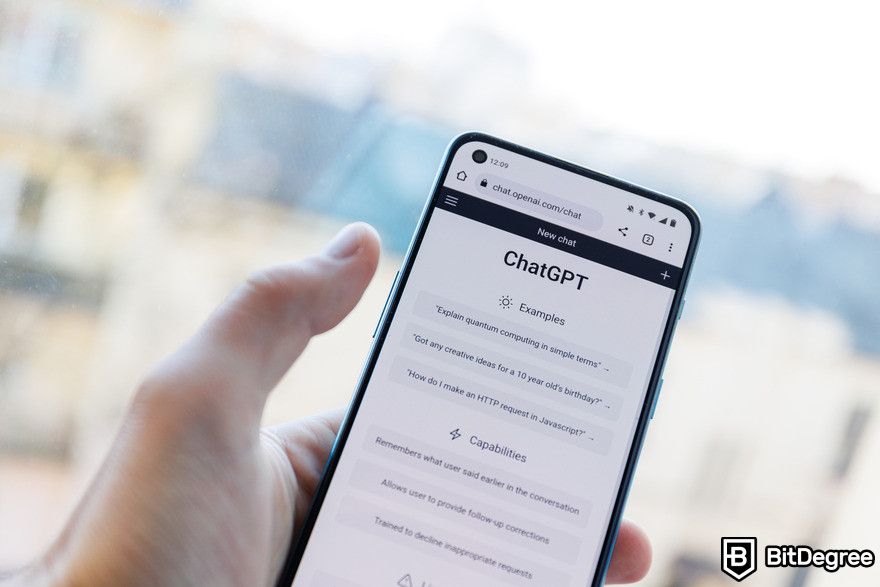
While ChatGPT can generate correct code snippets, it can also produce plausible-sounding but incorrect answers. This can lead to confusion, especially for beginners who still need to gain the experience to identify mistakes.
ChatGPT might not know specific project dependencies, configurations, or version compatibilities. It can suggest code that works in isolation but fails when integrated into the system.
Relying too heavily on ChatGPT for coding can impede learning. If you depend on AI to solve all your problems, you may miss out on understanding the underlying principles and best practices.

- Free to use
- Add-ons for Microsoft Word and Chrome
- Wide selection of tools
- Extensions for Chrome and Edge browsers
- Some tools are free
- Easy to use

- Supports over 120 voices in 20 languages
- Live customer support
- Voice cloning feature
- Voice cloning
- Emphasis and pauses
- Background music

- Easy to use
- AI-powered tools
- Cross-platform integration
- Multitrack editing
- AI-powered editing
- Accurate transcription
Best Practices for Integrating ChatGPT Into Your Workflow
Always review the ChatGPT code generations. Use it as a starting point rather than a final solution. Ensure the code aligns with your project’s standards and is secure and up-to-date.
Update your knowledge of best practices, frameworks, and libraries regularly. Cross-reference ChatGPT’s suggestions with the latest documentation and community guidelines to avoid implementing outdated or insecure code.
Be as specific as possible when asking for code snippets. Clear and detailed prompts lead to more accurate and relevant responses. For example, instead of asking for “a login function,” specify the language, framework, and any particular requirements like security measures.

Use an iterative approach. Break down complex tasks into smaller, manageable parts. Generate and test each part before moving on to the next. This helps in identifying and fixing issues early. Balance the use of ChatGPT code generation with traditional learning resources. Use books, tutorials, and courses to deepen your understanding. AI should complement your learning, not replace it.
Incorporate peer reviews into your workflow. Having another set of eyes on the code can catch errors and provide insights that AI might miss. Collaboration tools like GitHub facilitate peer reviews and version control.
Regularly perform security audits on your code. Use tools and practices to check for vulnerabilities. Automated tools like static code analyzers can help in identifying potential security issues. Ensure that ChatGPT code generation is well-documented and tested. Write unit and integration tests to validate the code's functionality and reliability if necessary.
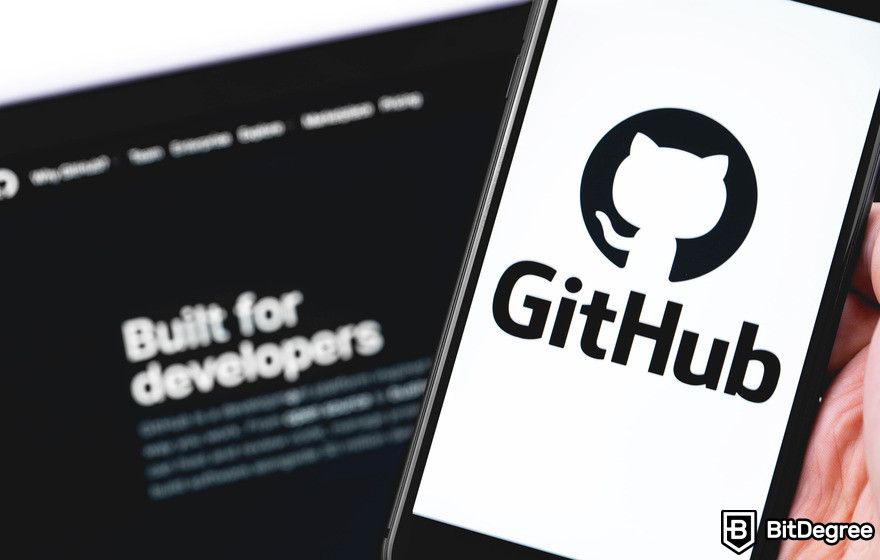
Recognize that ChatGPT is a tool with limitations. It’s excellent for generating initial code, exploring ideas, and automating repetitive tasks, but it’s not a substitute for experience and technical knowledge.
By acknowledging these limitations and following best practices, you can master ChatGPT while maintaining control and quality in your development projects. It's about finding the right balance - leveraging AI to enhance productivity without compromising on the quality and security of your code.
Case Studies and Real-World Examples
ChatGPT has found its way into various real-world coding projects, demonstrating its effectiveness. Here are some noteworthy examples:
ChatGPT code generation and optimization: ChatGPT assists developers by generating code snippets based on natural language descriptions. For instance, a developer needed a Python function to sum all even numbers in a list. By simply describing this requirement to ChatGPT, they received an accurate and efficient function, saving time and effort in manual coding.
Testing and debugging: Developers have used ChatGPT to automate test script creation, generate realistic test data, and even debug existing code. In one case, ChatGPT was used to simulate and fix issues related to the movement of cytoskeletons in bioinformatics research.

Documentation: Creating documentation is often a tedious task for developers. ChatGPT code generation has been leveraged to create detailed and accurate documentation swiftly. For example, when developers needed documentation for the 'requests' library in Python, ChatGPT provided step-by-step instructions and explanations, speeding up the process.
Project setup: As I showed you how can ChatGPT write code to set up entire projects, a notable instance involved a Django web application where ChatGPT guided the developer through creating models, views, and URL configurations, simplified the setup process and ensured all necessary components were correctly implemented.
Developers who have integrated ChatGPT into their workflows have praised its impact. Not one software engineer mentioned that ChatGPT drastically reduced the time spent on debugging and initial code and let them focus more on critical aspects of their projects.

Did you know?
Have you ever wondered which online learning platforms are the best for your career?
Conclusions
I’ve covered a lot of ground in exploring how ChatGPT can write code. From generating basic scripts to debugging and documenting code, ChatGPT looks like a universal tool for developers. Its ability to handle multiple programming languages and frameworks, offer live coding support, and assist with project setups makes it an assistant any developer should add to their toolkit.
While ChatGPT is powerful, it's necessary to approach it realistically. Experiment with it, and try other AI tools like Writesonic and Quillbot to enhance productivity and the quality of your work. ChatGPT suggestions can sometimes be outdated or insecure, so always review and test the code it generates.
The content published on this website is not aimed to give any kind of financial, investment, trading, or any other form of advice. BitDegree.org does not endorse or suggest you to buy or use any kind of AI tool. Before making financial investment decisions, do consult your financial advisor.
Scientific References
1. Y. Dong, X. Jiang, Z. Jin, et.al.: 'Self-collaboration Code Generation via ChatGPT';
2. C. Liu, X. Bao, H. Zhang, et.al.: 'Improving ChatGPT Prompt for Code Generation'.

.jpg?tr=w-400)







